Growing Friends April 2016 Plant Sale
You are here
The Growing Friends autumn sale is scheduled for 9 April and features Banksias and Hakeas that have put on some extraordinary growth over the warmer months. Banksias are excellent plants to encourage native birds and animals to the garden and can be quite sculptural additions to the landscape. The range on offer includes, Banksia aemula, caneii, coccinea, and several varieties of Banksia ericifolia; Hakea laurina, multilineata and petiolaris as well as a selection of Acacia, Boronia, Grevillea, Correa, Crowea, Patersonia and Pultenaea.
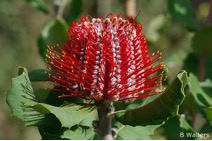
Banksia coccinea - Photo Brian Walters
Banksia coccinea is generally a shrub to about 4 metres but can grow taller. It is a very desirable garden plant because of its dramatic habit and spectacular flowers. It prefers sandy, very well drained soils, in full sun. The terminal flowers are ideal for cut flower arrangements. The spikes are about 100mm wide by a similar length and are held terminally on the stems. They are seen in late winter through to early summer (June to January). The seeds are enclosed in follicles attached to a woody cone and are generally retained within the cone until burnt. The plant is fire-sensitive in that it does not have lignotuber for vegetative regeneration after bushfires. The species relies on seed for regeneration.
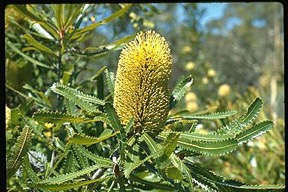
Banksia aemula - Photo A. McWhirter
Banksia aemula grows as a robust tree to about 8m of height or can remain as a chunky, spreading shrub that grows in an irregular manner, often giving it the appearance of being sculptured. It has a ‘heavy’ appearance, the trunk appearing quite large relative to the tree. The reddish coloured bark is corky and attractive and it would be useful as a screening plant in the garden or make an interesting tree feature. Flowering generally occurs in autumn and early winter (March to June). Well drained soils are necessary to replicate its ‘Wallum’ habitat. All heathland species prefer full sun throughout the day, and if shaded for part of the day will be less robust and produce fewer flowers.
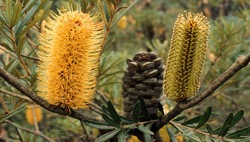
Banksia caneii - Photo Brian Walters
Banksia caneii is generally a shrub to about 3 metres. It has attractive smooth bark and small leaves. Peak season for new growth is autumn and flower spikes are cream to light yellow in colour and may have a bluish tinge at the bud stage. The spikes are about 70mm wide and up to 100 mm long and occur in late summer to early winter (January to June). It grows on rocky, sometimes loamy, soils on mountain slopes and a slightly heavier soil may suit it in the garden (though drainage must remain good). Occurs naturally in open forest and woodland in mountains of southern New South Wales and north-eastern Victoria above 600 metres.
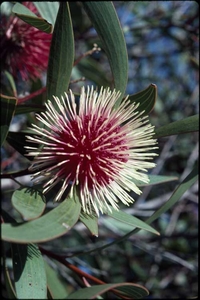
Hakea laurina - Photo Murray Fagg
Hakea laurina is one of the most admired native plants of south-western Australia and is grown in quantity in Australia and other countries. In Italy and America its uses include street and hedge planting. In the Australian National Botanic Gardens it is grown as a shrub or small tree reaching 5 m. The best specimens are in open beds of light soil, watered but well drained. In full sun the species forms an upright shrub with a compact, rounded head, flowering freely and evenly each year. Flowering starts towards the end of April, is at its best in July in a mild winter and ends towards the end of August. Moderate pruning and shaping may be done as required and short stems of flowers may be cut for indoor decoration.
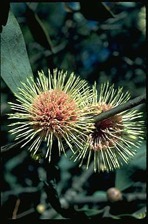
Hakea petiolaris - Photo D. Greig
Hakea petiolaris is an erect shrub to small tree reaching 2-9 metres in height. Flowers are seen in late autumn and early winter and occur in globular-shaped clusters, rather like a sea urchin (hence the common name), each containing 120-200 individual flowers. Young inflorescences are creamish in colour. Prefers well drained soil and preferably acid. Like many Western Australian plants, it is susceptible to root rot in humid eastern summers but appears to be hardier than many other western hakeas. It is fairly quick growing and appears to be tolerant of moderate frosts.The flowers are attractive to honey-eating birds and the species is best grown in an open, sunny position.

